Methods of Attack
Tactics and Strategies
Primary Methods of Attack
Direct
- The direct attack approach attacks the fire itself (Coleman, et al. 585).
It is generally best suited for small and/or slowly spreading fires that
are burning with few fuels in the area or fuels that contain a high moisture
content (National Wildfire Coordinating Group 16).
The point of initial attack is referred to as the anchor point. From
the anchor point, the flanks of the fire are then attacked the head
or leading edge of the fire is reached. The most aggressive flank is
attacked first unit the fire is eventually surrounded and extinguished.
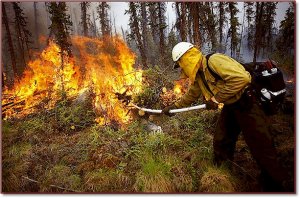
Photo Courtesy of fire.ak.blm.gov
Indirect
- The indirect approach is used for larger fires that are
spreading rapidly. Crews move ahead of the fire and remove any fuels
in the fires path in order to slow or stop the fire's progression (Coleman, et al. 586).
One means of removing the fuel in front of the head of the fire is
the use of backfiring. Backfiring is an intentional burn that
eliminates the fuel in front of a fire in order to widen control
lines, change the direction of a fire, or slow the fire's progress (Perry 203).
One method of backfiring is shown below.
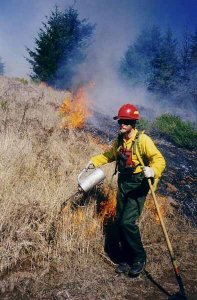
Photo Courtesy of WildlandFire.com
Parallel
- Parallel attacks are similar to the previous attack methods.
They are almost a combination between the two actually. Both flanks
of the fire are attacked simultaneously only farther from the fire line than
in the direct attack, thereby containing the fire between
two parallel control lines. By using a process referred to as burnout shown below,
the unburned fuels between the two parallel control lines and the fire are then
burned (Perry 201).
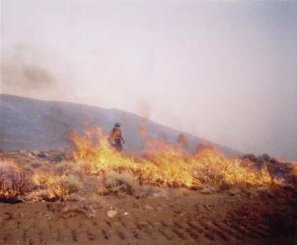
Photo Courtesy of WildlandFire.com
Equipment
- Air Support
- Rotary and fixed wing aircraft play a vital
role in wildland fire operations. They can assist in the deployment
of handcrews and smoke jumpers, provide reconnaissance of the affected
area, as well as provide fire suppression through water and retardant
drops.
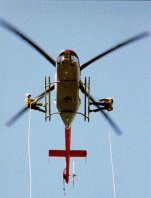
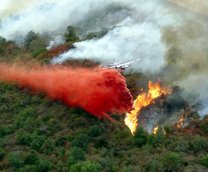
Photos Courtesy of WildlandFire.com
- Engines/ Brush Trucks/ Tenders
- These apparatus are used
primarily to transport water and firefighters to the fire scene.
An apparatus will be deployed to the fire scene depending on its
capabilities and the fire conditions. For example, a brush truck
may be deployed to an area that may be impassible by and engine
or tender.
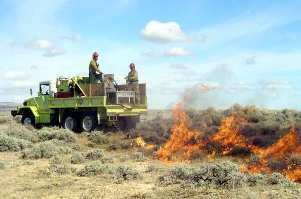
Photo Courtesy of WildlandFire.com
- Bulldozers/Heavy Equipment
- Bulldozers and heavy equipment can be utilized in virtually every
attack method if they are available and circumstances permit them
to be deployed. They are used to create control lines, clear brush
and large debris, and enhance natural barriers among other varied uses. These machines are
especially good on the fireline since they can usually withstand a
greater amount of heat than a handcrew worker provided the proper
safety gear for the driver it utilized.
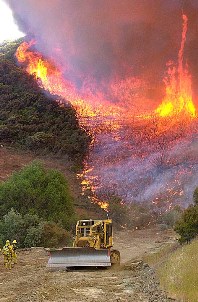
Photos Courtesy of WildlandFire.com
- Pumps
- Pumps are used to transport the water to the fire scene from
ground based water supplies. This can be from natural water sources,
fire apparatus, or Fold-a-tanks. The pumps pictured below are used in
conjunction with a brush truck.

Photo Courtesy of WildlandFire.com
Home|
Fire Basics|
Wildland Basics|
Fire Behavior|
Methods of Attack|
References
Heather Christian
fnhlc@uaf.edu
Phys 212x-SF05-General Physics II
Last update 03/17/2005










